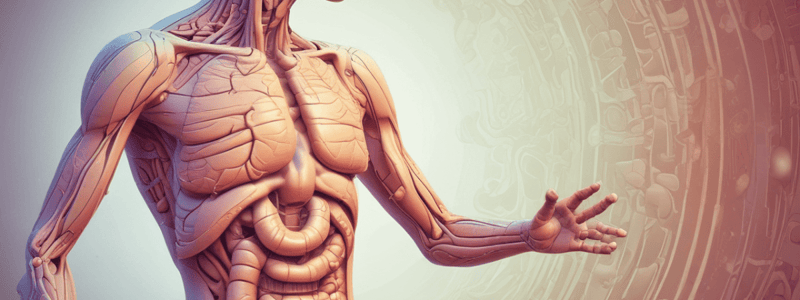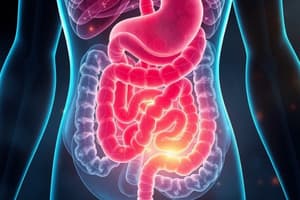Podcast
Questions and Answers
What distinguishes the gastrointestinal (GI) tract from accessory digestive organs?
What distinguishes the gastrointestinal (GI) tract from accessory digestive organs?
- The GI tract is considered part of the body while materials in accessory organs are not.
- GI tract breaks down food into smaller components while accessory organs produce secretions.
- Accessory organs empty secretions into the GI tract while the GI tract absorbs nutrients.
- The GI tract is lined with a mucous membrane while accessory digestive organs are not. (correct)
Which organs are considered accessory digestive glands?
Which organs are considered accessory digestive glands?
- Kidneys and lungs
- Salivary glands, liver, and pancreas (correct)
- Heart and brain
- Stomach and small intestine
What role do the teeth and tongue play in digestion?
What role do the teeth and tongue play in digestion?
- Concentrating secretions from the liver
- Storing bile for secretion
- Producing enzymes for digestion
- Participating in chewing and swallowing food (correct)
Why are optimal digestion and absorption dependent on regulating the environmental conditions within the GI tract?
Why are optimal digestion and absorption dependent on regulating the environmental conditions within the GI tract?
Where do materials within the lumen of the GI tract become considered part of the body?
Where do materials within the lumen of the GI tract become considered part of the body?
What do accessory digestive glands produce?
What do accessory digestive glands produce?
What is the role of the epithelium in the process of absorption within the GI tract?
What is the role of the epithelium in the process of absorption within the GI tract?
Which type of epithelium is typically found in most of the GI tract, including the stomach and small intestine?
Which type of epithelium is typically found in most of the GI tract, including the stomach and small intestine?
What is the function of the lamina propria in the mucosa of the GI tract?
What is the function of the lamina propria in the mucosa of the GI tract?
Which layer of the mucosa contains small blood and lymph vessels?
Which layer of the mucosa contains small blood and lymph vessels?
What type of epithelium lines parts of the GI tract that must withstand abrasion?
What type of epithelium lines parts of the GI tract that must withstand abrasion?
In which layer of the mucosa are substances moved through simple columnar epithelial cells for absorption?
In which layer of the mucosa are substances moved through simple columnar epithelial cells for absorption?
What is the composition of the muscularis in the gastrointestinal (GI) tract?
What is the composition of the muscularis in the gastrointestinal (GI) tract?
Which layer of the smooth muscle cells in the muscularis is oriented circumferentially within the GI tract wall?
Which layer of the smooth muscle cells in the muscularis is oriented circumferentially within the GI tract wall?
What is the function of the myenteric nerve plexus?
What is the function of the myenteric nerve plexus?
How can the relative orientation of the two layers of smooth muscle in the muscularis be visualized according to the text?
How can the relative orientation of the two layers of smooth muscle in the muscularis be visualized according to the text?
What is the primary function of the muscularis in the GI tract?
What is the primary function of the muscularis in the GI tract?
Where are the fine branches of nerves and autonomic ganglia located in relation to the layers of smooth muscle in the muscularis?
Where are the fine branches of nerves and autonomic ganglia located in relation to the layers of smooth muscle in the muscularis?
Which structure is often referred to as the 'fatty apron'?
Which structure is often referred to as the 'fatty apron'?
What is the function of the falciform ligament?
What is the function of the falciform ligament?
Which mesentery is a fold suspending most of the small intestine?
Which mesentery is a fold suspending most of the small intestine?
To which organ does the lesser omentum connect?
To which organ does the lesser omentum connect?
What is the characteristic shape of the falciform ligament?
What is the characteristic shape of the falciform ligament?
Which mesentery attaches the large intestine to the posterior abdominal wall?
Which mesentery attaches the large intestine to the posterior abdominal wall?
What is the primary difference between mixing and propulsion in the GI tract?
What is the primary difference between mixing and propulsion in the GI tract?
What is peristalsis in the context of GI motility?
What is peristalsis in the context of GI motility?
How does the pyloric sphincter function in the GI tract?
How does the pyloric sphincter function in the GI tract?
What is the purpose of a sphincter within the GI tract?
What is the purpose of a sphincter within the GI tract?
How does segmentation in the small intestine contribute to GI motility?
How does segmentation in the small intestine contribute to GI motility?
What is a significant function of peristalsis within the GI tract?
What is a significant function of peristalsis within the GI tract?
What happens when substances are moved through the simple columnar epithelial cells lining the GI tract wall?
What happens when substances are moved through the simple columnar epithelial cells lining the GI tract wall?
Which layer of the mucosa in the GI tract contains small blood and lymph vessels?
Which layer of the mucosa in the GI tract contains small blood and lymph vessels?
What is the primary function of the lamina propria in the mucosa of the GI tract?
What is the primary function of the lamina propria in the mucosa of the GI tract?
Which type of epithelium lines parts of the GI tract that must withstand abrasion?
Which type of epithelium lines parts of the GI tract that must withstand abrasion?
In absorption, where are substances moved through in the mucosa of the GI tract?
In absorption, where are substances moved through in the mucosa of the GI tract?
What is the function of propulsion in the context of GI motility?
What is the function of propulsion in the context of GI motility?
How are accessory digestive organs distinguished from the gastrointestinal (GI) tract?
How are accessory digestive organs distinguished from the gastrointestinal (GI) tract?
What is the primary role of the gallbladder in the digestive system?
What is the primary role of the gallbladder in the digestive system?
How do materials within the lumen of the GI tract relate to the body?
How do materials within the lumen of the GI tract relate to the body?
What does the salivary gland contribute to digestion in the GI tract?
What does the salivary gland contribute to digestion in the GI tract?
Which organs are classified as accessory digestive glands?
Which organs are classified as accessory digestive glands?
What is a distinctive feature of the mucous membrane lining the GI tract?
What is a distinctive feature of the mucous membrane lining the GI tract?
What is the effect of parasympathetic innervation on the GI tract?
What is the effect of parasympathetic innervation on the GI tract?
Which cranial nerve extends to the parotid gland to stimulate salivary secretions?
Which cranial nerve extends to the parotid gland to stimulate salivary secretions?
What is the main function of sympathetic innervation in the GI tract?
What is the main function of sympathetic innervation in the GI tract?
Which division is responsible for inhibiting GI tract motility and release of secretions?
Which division is responsible for inhibiting GI tract motility and release of secretions?
What may interfere with digestion by activating the sympathetic division?
What may interfere with digestion by activating the sympathetic division?
Which type of axons are involved in regulating digestive activities in the GI tract?
Which type of axons are involved in regulating digestive activities in the GI tract?
What receptors initiate GI reflexes by detecting stretch of the GI tract wall and monitoring chemical content within the lumen?
What receptors initiate GI reflexes by detecting stretch of the GI tract wall and monitoring chemical content within the lumen?
Which of the following correctly describes the parietal peritoneum?
Which of the following correctly describes the parietal peritoneum?
What is the potential space between the parietal and visceral peritoneum called?
What is the potential space between the parietal and visceral peritoneum called?
Which membrane is continuous with the posterior abdominal wall and covers internal organs within the abdominopelvic cavity?
Which membrane is continuous with the posterior abdominal wall and covers internal organs within the abdominopelvic cavity?
What is the function of the mesentery in relation to the abdominopelvic cavity?
What is the function of the mesentery in relation to the abdominopelvic cavity?
Which term describes the characteristic shape of the falciform ligament?
Which term describes the characteristic shape of the falciform ligament?
What type of peritoneal fold attaches the liver to the internal surface of the anterior abdominal wall?
What type of peritoneal fold attaches the liver to the internal surface of the anterior abdominal wall?
Which mesentery extends inferiorly like an apron from the inferolateral surface of the stomach?
Which mesentery extends inferiorly like an apron from the inferolateral surface of the stomach?
What is the primary function of the mesocolon in relation to the large intestine?
What is the primary function of the mesocolon in relation to the large intestine?
Which structure is sometimes referred to as the 'fatty apron' and stores fat in the abdominal cavity?
Which structure is sometimes referred to as the 'fatty apron' and stores fat in the abdominal cavity?
What connects the superomedial surface of the stomach and the proximal end of the duodenum to the liver?
What connects the superomedial surface of the stomach and the proximal end of the duodenum to the liver?
In which structure is most of the small intestine (the jejunum and ileum) suspended from in the abdominal cavity?
In which structure is most of the small intestine (the jejunum and ileum) suspended from in the abdominal cavity?
What is the primary role of the lamina propria in the mucosa of the GI tract?
What is the primary role of the lamina propria in the mucosa of the GI tract?
How can the relative orientation of the two layers of smooth muscle in the muscularis be visualized?
How can the relative orientation of the two layers of smooth muscle in the muscularis be visualized?
What may interfere with digestion by activating the sympathetic division?
What may interfere with digestion by activating the sympathetic division?
Which mesentery extends inferiorly like an apron from the inferolateral surface of the stomach?
Which mesentery extends inferiorly like an apron from the inferolateral surface of the stomach?
In terms of GI motility, how does segmentation in the small intestine contribute?
In terms of GI motility, how does segmentation in the small intestine contribute?
What do accessory digestive glands produce?
What do accessory digestive glands produce?
What distinguishes a short reflex from a long reflex in the context of the GI tract?
What distinguishes a short reflex from a long reflex in the context of the GI tract?
Which primary hormones are released into the blood and participate in the regulation of digestion?
Which primary hormones are released into the blood and participate in the regulation of digestion?
What is the primary role of autonomic motor output in the context of GI reflexes?
What is the primary role of autonomic motor output in the context of GI reflexes?
How do long reflexes differ from short reflexes in terms of sensory input?
How do long reflexes differ from short reflexes in terms of sensory input?
What is the function of gastrin in the digestive system?
What is the function of gastrin in the digestive system?
In the context of GI tract reflexes, what role does the ENS play in short reflexes?
In the context of GI tract reflexes, what role does the ENS play in short reflexes?
What is the primary effect of gastrin on stomach motility and secretions?
What is the primary effect of gastrin on stomach motility and secretions?
Which hormone is responsible for stimulating the release of enzyme-rich pancreatic juice?
Which hormone is responsible for stimulating the release of enzyme-rich pancreatic juice?
What is the primary function of secretin in response to acidic chyme?
What is the primary function of secretin in response to acidic chyme?
Which hormone regulates migrating motility in the small intestine complex?
Which hormone regulates migrating motility in the small intestine complex?
What is the function of hepcidin in response to increased iron content in chyme?
What is the function of hepcidin in response to increased iron content in chyme?
What is the primary target of somatostatin in modulating nearby acidity?
What is the primary target of somatostatin in modulating nearby acidity?
What is the primary function of the gastrointestinal (GI) tract?
What is the primary function of the gastrointestinal (GI) tract?
How long is the gastrointestinal (GI) tract in an adult cadaver?
How long is the gastrointestinal (GI) tract in an adult cadaver?
Which of the following organs is NOT part of the gastrointestinal (GI) tract?
Which of the following organs is NOT part of the gastrointestinal (GI) tract?
What is the alternative name for the gastrointestinal (GI) tract?
What is the alternative name for the gastrointestinal (GI) tract?
Where does the gastrointestinal (GI) tract end?
Where does the gastrointestinal (GI) tract end?
What is the main role of accessory digestive organs in the digestive process?
What is the main role of accessory digestive organs in the digestive process?
What distinguishes retroperitoneal organs from other abdominal organs?
What distinguishes retroperitoneal organs from other abdominal organs?
Which of the following is true regarding the adventitia of retroperitoneal organs?
Which of the following is true regarding the adventitia of retroperitoneal organs?
Which organ is NOT considered a retroperitoneal digestive organ?
Which organ is NOT considered a retroperitoneal digestive organ?
What mnemonic can be used to remember the retroperitoneal organs?
What mnemonic can be used to remember the retroperitoneal organs?
Which system are retroperitoneal organs associated with?
Which system are retroperitoneal organs associated with?
What does the term 'mesentery' refer to in relation to the GI tract?
What does the term 'mesentery' refer to in relation to the GI tract?
Flashcards are hidden until you start studying




